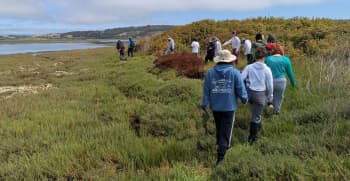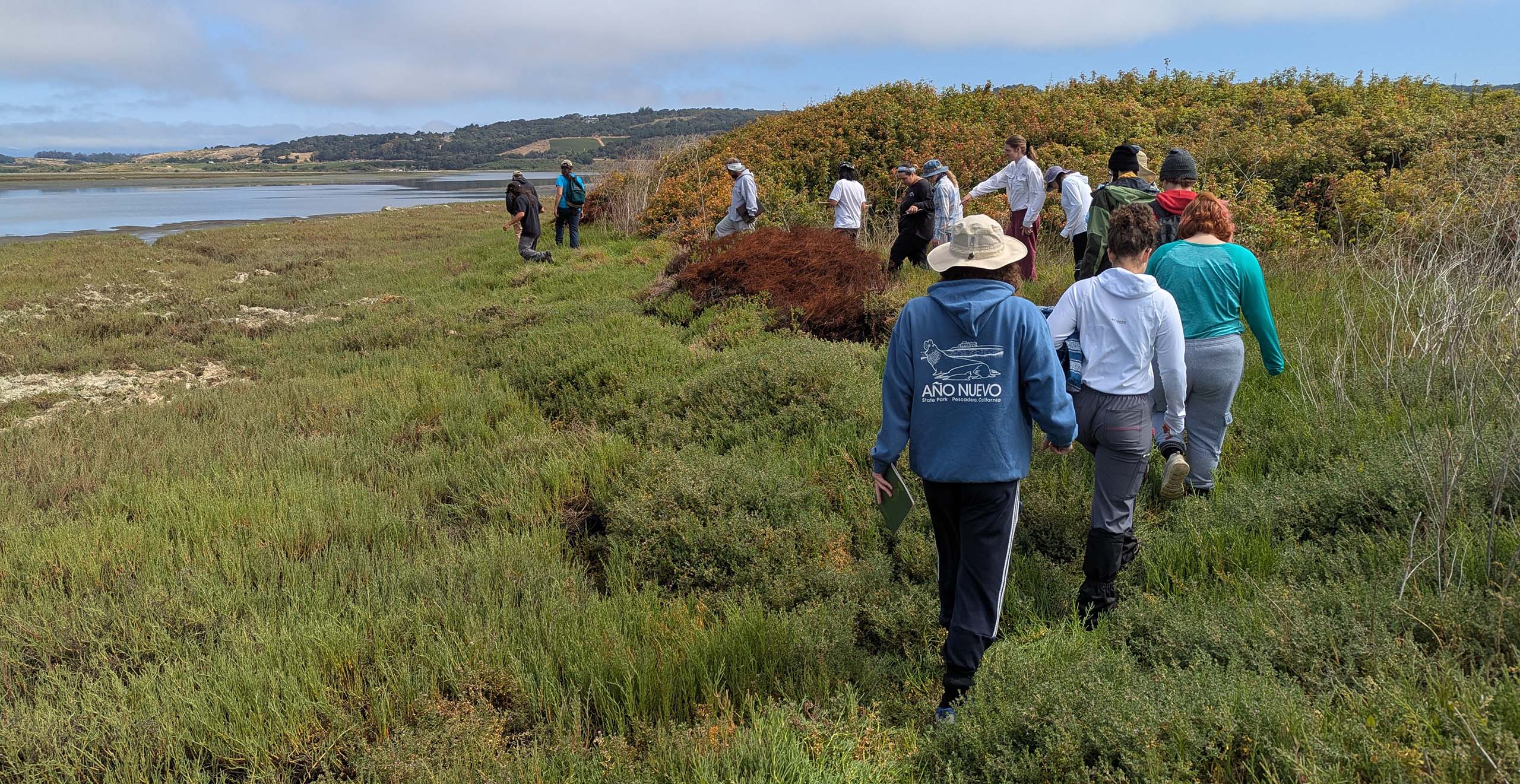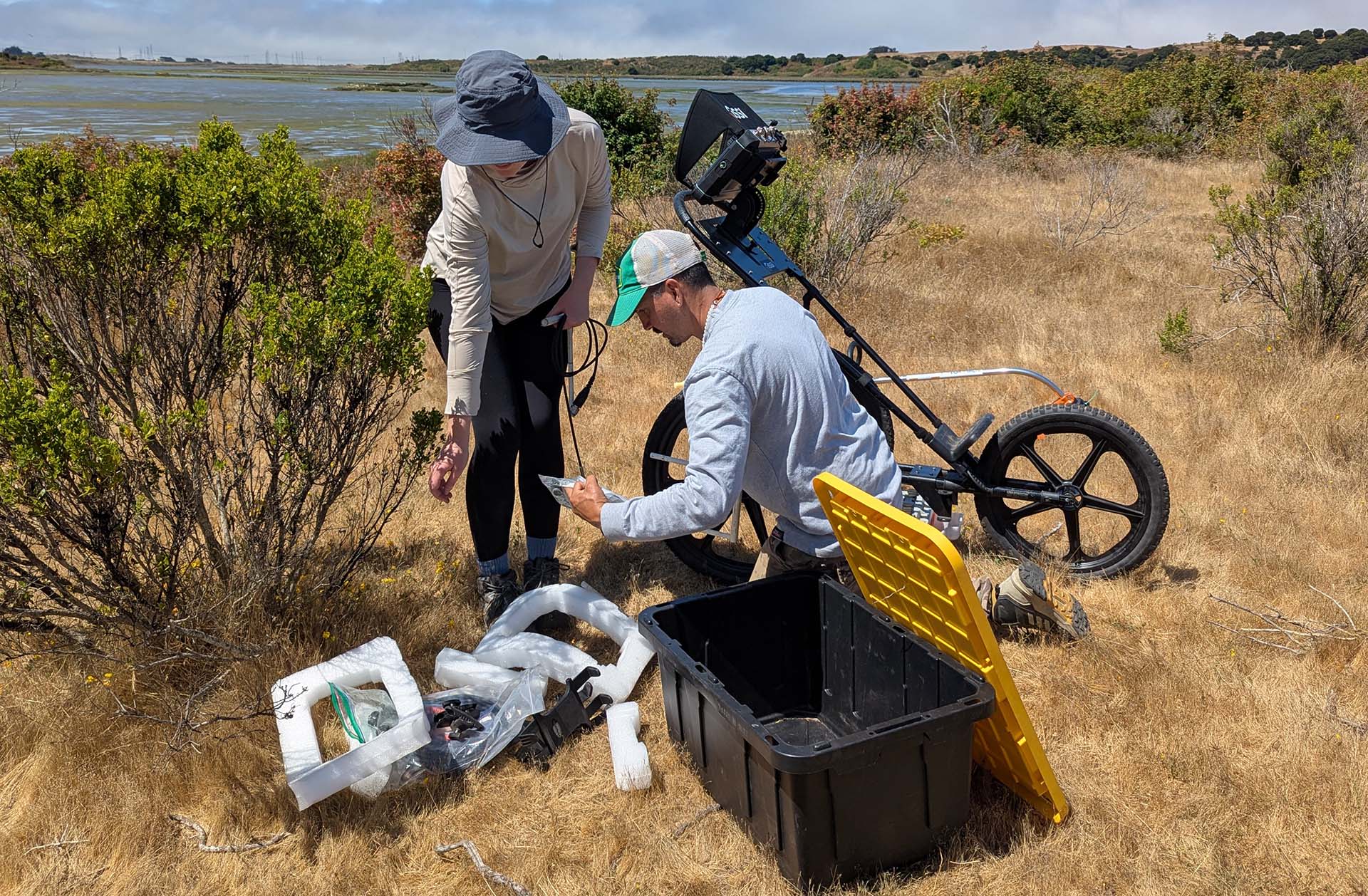The UO's Museum of Natural and Cultural History is helping shift the way archaeology happens
Story and photos by Lexie Briggs • October 29, 2025
As the scent of burning sage cuts through the chilly morning air on the central California coast, two dozen young adults gathered around Gabe Sanchez to discuss the day's work.
Here as part of the University of Oregon's Museum of Natural and Cultural History summer field school, the students are spending a month immersed in Indigenous cultural landscapes while studying archaeology, history and ecology and, at the same time, helping restore oyster beds. They're learning vital career skills while helping usher in a new era of archaeology.
The summer course draws students from the UO as well as other universities around the country, who live, learn and work on the central California coast in partnership with the Amah Mutsun Tribal Band and the Amah Mutsun Land Trust.
"This is the future of archaeology, moving away from colonial structures and doing work that supports tribal sovereignty, access to ancestral lands and serves the people the work represents," says Gabe Sanchez, an Indigenous anthropologist and assistant professor in the UO's anthropology and Native American and Indigenous studies departments. "University of Oregon students are at the forefront of this work, working hand in hand with tribal members, learning and working together."
A new vision for archaeology
When you hear "archaeology field school," a few images might pop to mind: crews with shovels digging meters-deep holes to find buried treasure, fedoras and bullwhips at the ready. That image speaks to an older model of archaeology, extracting material culture by digging up things people had left behind hundreds or thousands of years ago, often without accounting for oral histories and traditional ecological knowledge from local Indigenous communities.
Today, field schools are still vital training grounds for budding archaeologists. But this field school reflects a new focus in the field of archaeology: working not just in consultation with tribes but following the lead of tribes and descendant communities.
These archaeologists are posing questions, like how can archaeology inform and integrate with other academic disciplines such as restoration ecology? And what do descendant communities want to know about the past, and can those questions be answered by archaeology?
"It's about the past, but really it's about the future," said Elizabeth Rodriguez, a field school student and Amah Mutsun tribal member.
The Museum of Natural and Cultural History runs field schools at research sites around Oregon and beyond. The opportunity for this field school arose thanks to Sanchez's longstanding relationships with the Amah Mutsun Tribal Band and support from tribal Chair Valentin Lopez.
Image captions
 Image 1
Image 1Students hike into Elkhorn Slough.

Students hike into Elkhorn Slough.
Students hike into Elkhorn Slough.
The tribe is not federally recognized and has no protected reservation lands, but its people have lived in what is today central California since time immemorial. Through the Amah Mutsun Land Trust, the tribe works to restore Indigenous knowledge and practices to ancestral lands through research and education, conservation and restoration, and Indigenous stewardship.
One such effort centers on Elkhorn Slough, which sits just north of Monterey. Oysters, once abundant as both a traditional food source and part of a dynamic ecosystem, are now being reintroduced after decades of absence. Looking to the past can offer clues to how to help these restoration efforts succeed.
"Archaeology has the opportunity to support or subvert tribal sovereignty," said Alec Apodaca, cultural resources program manager for the Amah Mutsun Land Trust. "Here, the tribe is using archaeology as a way to guide restoration and look at what people were eating and stewarding in the past. Research and access to traditional foods is a top priority."
"This is the future of archaeology, moving away from colonial structures and doing work that supports tribal sovereignty, access to ancestral lands and serves the people the work represents."
'Everything remains in place'
As the dig begins at Elkhorn Slough, it's clear that this is not archaeology as it is depicted in the media and in popular news articles. The work crews are made up of students and professors as well as young adults from the Amah Mutsun Land Trust's Native Stewardship Corps, a program that engages young adult tribal members in research, conservation and education work.
Most morning meetings conclude with a gratitude stretch from everyone present and a cleansing with mugwort and sage. And, once the work begins, students use state-of-the-art techniques and technology to work as noninvasively as possible.
At the slough, instead of deep excavation pits, students identify points of interest with geophysical methods like ground-penetrating radar. In groups of four, students use satellite technology to pinpoint places to survey as they look for the boundaries of the site.
Once those points are mapped, archaeologists clear a 1-meter area of any plants, such as poison oak or abundant native plants like pickleweed, and begin filling a pitcher with two liters of surface dirt. Pouring the dirt onto small screens, they sift for shell fragments, stone tools or animal bones to find the boundaries of a shell midden, a place where people once processed massive amounts of clams, mussels and oysters.
This low-impact survey method was developed by the Amah Mutsun Tribal Band and leaves a noninvasive look on the surface with cultural materials returned to their original location following in-field analyses.
In other words, as Sanchez reiterated as part of the morning meeting, "everything remains in place."

The ecology of Elkhorn Slough has always been in flux, changing from a fresh-water estuary to an estuary with brackish water several times over the past few millennia. Today, the slough is a wetland without a stable oyster population, but thousands of years ago the Amah Mutsun Tribal Band used the area as a mollusk processing site, harvesting hundreds of pounds of oysters each year.
Ostria lurida, also known as the Olympia oyster, is the only oyster native to the northern Pacific coast of North America and was a staple food for Indigenous people along the coast of Northern California, Oregon, Washington and through British Columbia into Alaska.
The species is threatened by habitat and climate change, as well as the commercial introduction of farmed oysters from Japan and elsewhere. The midden studied by the tribe and students suggests Elkhorn Slough was once a place where native oysters thrived, cultivated by the Amah Mutsun people living there.
As ecologists look to reintroduce oysters to the slough waters, the archaeology from the tribe and the field school are instrumental in framing the goals of restoration.
The research questions for today are focused: What are the boundaries of the shell midden? How many of the shells are oyster versus clam versus mussel? How have Indigenous harvesting practices influenced those populations over time? And how can this knowledge guide the restoration work between the tribe and the slough?
Throughout the day, students painstakingly document the location of shell fragments. They work diligently, aware that there is time pressure for their day as well as for the site itself: This site is at risk of destruction due to sea level rise. This is the second year the field school has worked here, and each year could be the last.
An interdisciplinary approach
Although the archaeology wrapped up at about 3 p.m., the day wasn't quite done. After the hike back to the trucks at the mouth of the slough, field school students cooked dinner for the entire crew of archaeologists and stewards and welcomed a local expert for a talk. The field school's evening talks highlight a variety of perspectives and voices, from the Amah Mutsun Tribal Band chair to professional archaeologists, historians, agency partners and other tribes.
Today they welcomed Martin Rizzo-Martinez, an assistant professor in the Film and Digital Media Department at the University of California, Santa Cruz and one of the top experts in Amah Mutsun tribal history, who discussed how pairing archaeology and oral history with official written records is vital to a complete understanding of history.
"Exposure to interdisciplinary approaches is critical in order to discourage the formation of academic silos," Sanchez said.
This summer the students learned from Amah Mutsun tribal members, neighboring tribes, ecologists, historians and academic and compliance professionals.
"Through these practices, we're breaking down those barriers," he said.
"I like being out here; that's where I feel at my happiest. I have little moments in my life where I look around and I'm like, wow. This is where I'm meant to be."
Research that reaches beyond departmental definitions-beyond science, social science and the humanities-is one way in which we are reaching a fuller understanding of the past.
People, specifically Indigenous people, have been key players in North American ecosystems, driving biological and geophysical changes since time immemorial. Archaeology is, in many ways, the missing link between life sciences and history, between our understanding of who we are and the world around us, according to Sanchez.
By weaving together practices from archaeology, ecology and traditional ways of knowing, this project connects not just to the past in Elkhorn Slough but creates a map for stewarding its future.
It's a new way of thinking about archaeology, Sanchez said, but it's a very old way of thinking about the world and our place in it.
"I like being out here; that's where I feel at my happiest," Rodriguez said, looking out over the slough where her ancestors once shucked oysters. "I have little moments in my life where I look around and I'm like, wow. This is where I'm meant to be."






